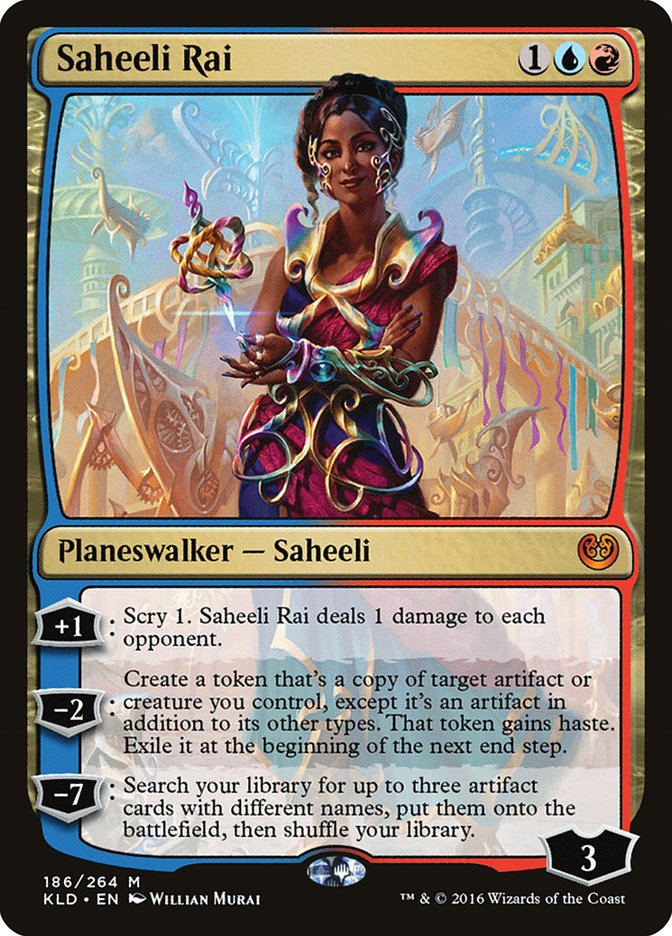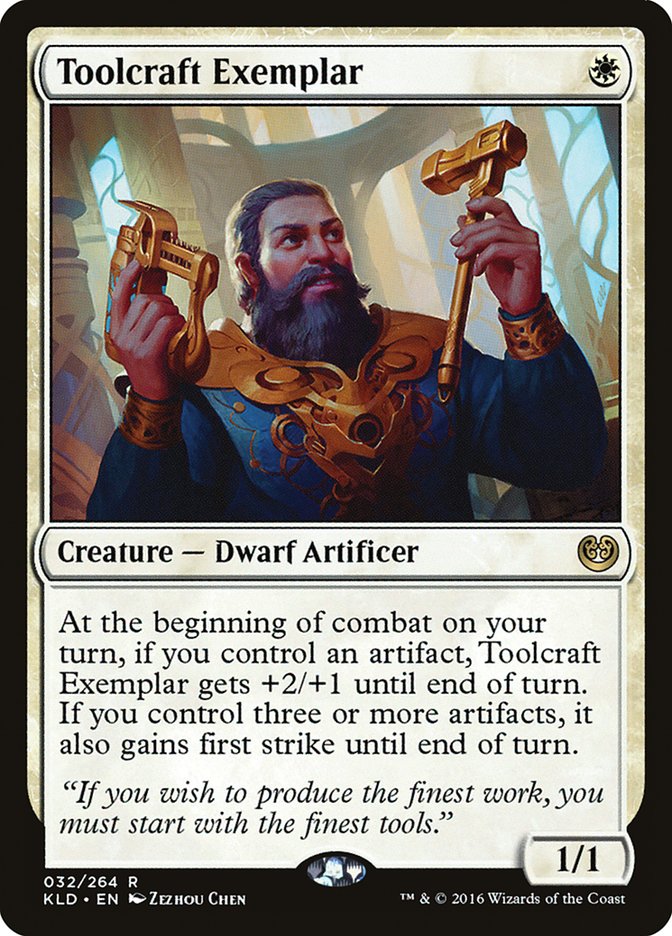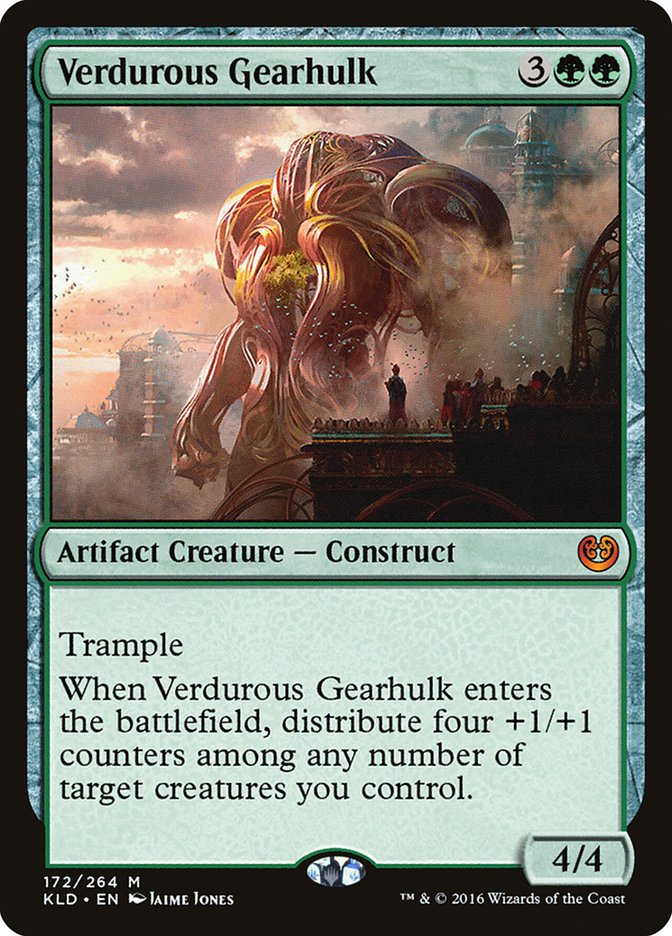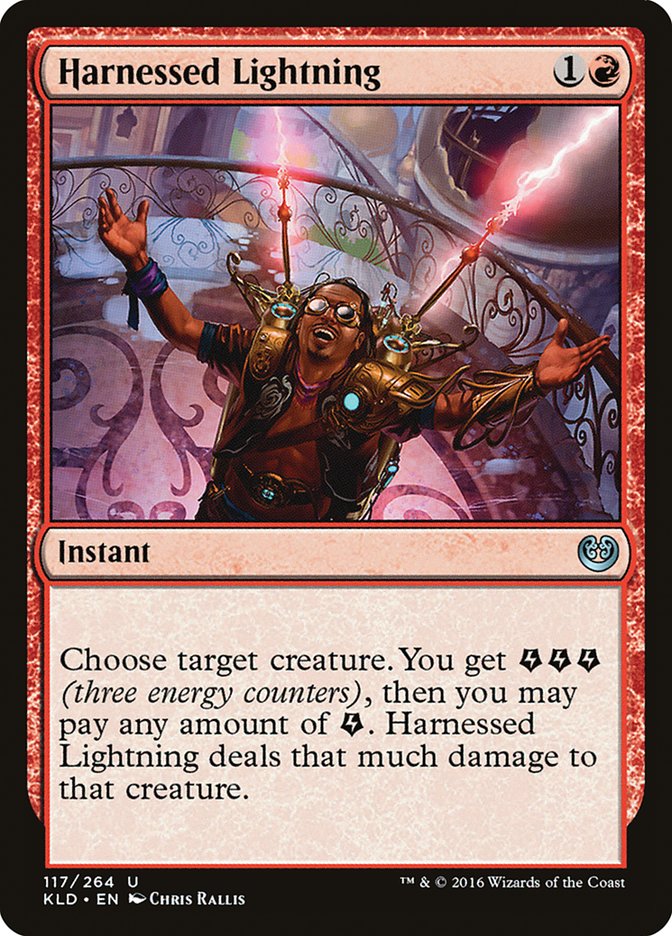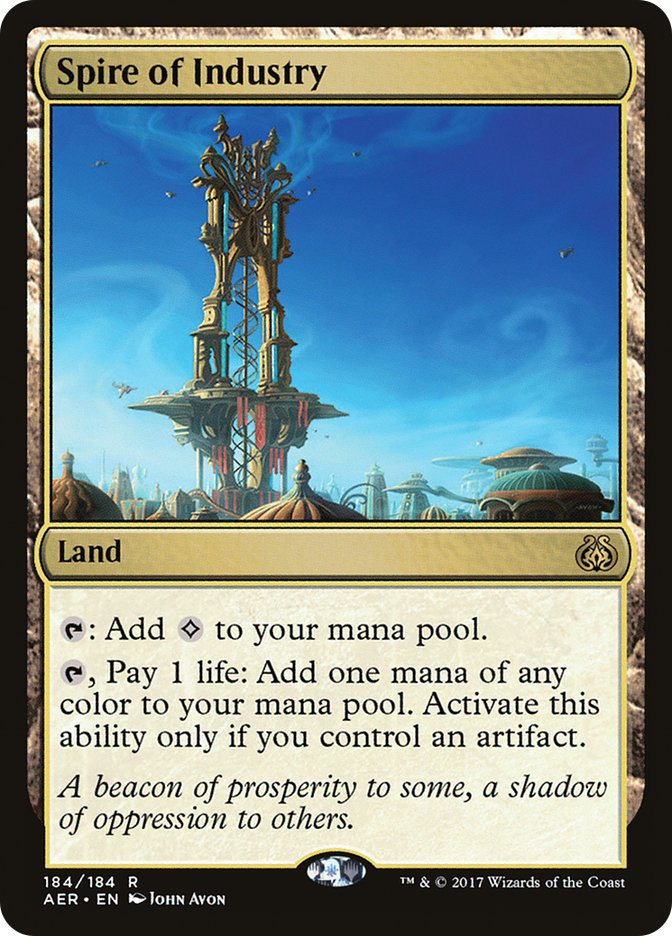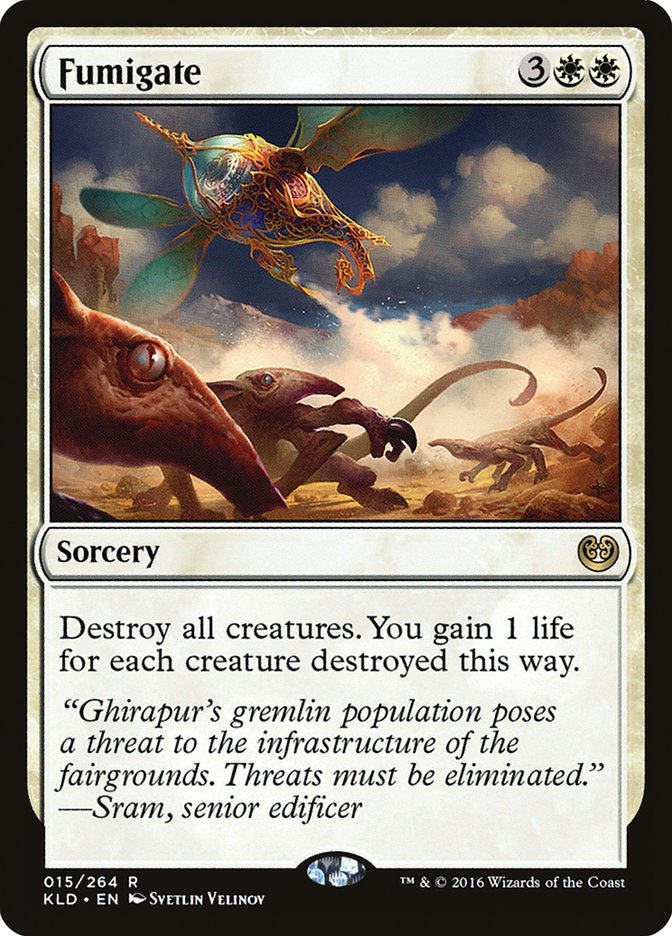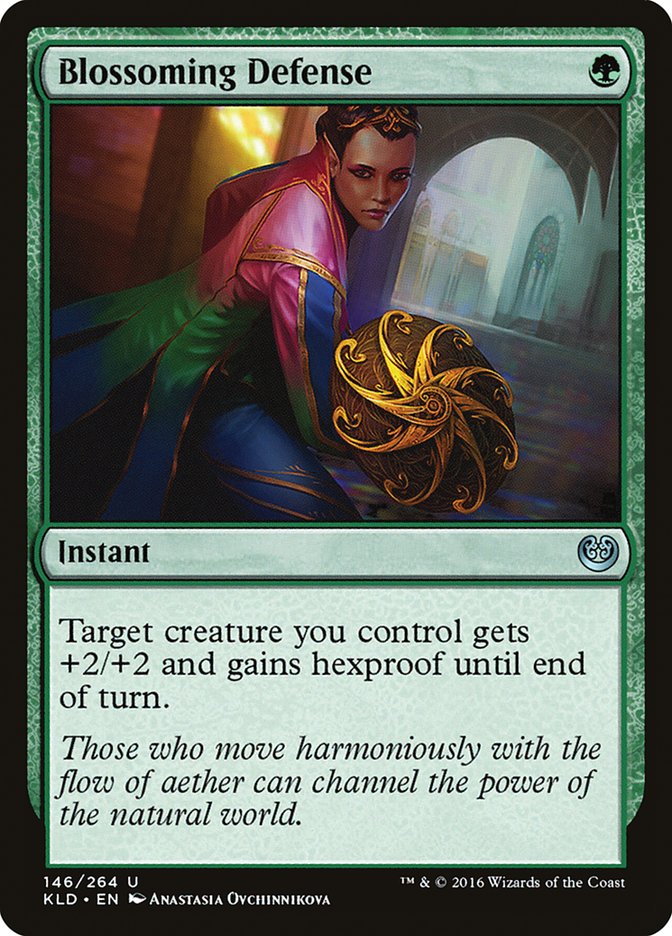Aether Revolt Standard is all about three pillars.
A pillar is a card that defines a strategy, either as a build-around or as a payoff for choosing that archetype. Oftentimes, the pillars will invalidate other strategies or similar cards. In this case, Verdurous Gearhulk invalidates a lot of other five-drops, as using those cards is often less powerful than building around the green mythic.
The pillars of a format can, and often do, change. If Standard suddenly revolves around Fumigate, then Verdurous Gearhulk is less good. Similarly, if Aetherworks Marvel makes a comeback, then Verdurous Gearhulk probably isn’t the thing you’ll want to builld around.
Since Verdurous Gearhulk is very popular (and will likely increase in popularity before it decreases), that should also tell you something about the format. If Verdurous Gearhulk were worse, people wouldn’t play it.
Standard is about getting onto the battlefield and pressing that advantage. Without Emrakul, the Promised End, there are very few late-game cards worth building toward. Since that’s the case, Verdurous Gearhulk is the biggest, baddest thing around.
Toolcraft Exemplar is the best available beatdown tool, whereas Saheeli Rai (or Felidar Guardian) is trying to play foil to everything.
Right now, if you’re not building your deck around one of these three cards, you’re doing it wrong.
The Saheeli Rai / Felidar Guardian combo was the focal point of SCG Columbus coverage. It seemed like every round had some iteration of the deck on camera. It won some, it lost some, but at the end of Day 1, you knew the deck was for real.
Players who opted to try the combo were split into two camps, Four-Color Saheeli and Jeskai Saheeli.
The four-color version bears a resemblance to the Reveillark decks of old, slowly accruing value while simultaneously threatening a combo kill. In most games where the combo ends the game, things were probably going fine for them anyway.
Here is Team CardHoarder’s version:
Creatures (20)
- 4 Spell Queller
- 2 Cloudblazer
- 1 Whirler Virtuoso
- 4 Servant of the Conduit
- 4 Rogue Refiner
- 1 Shielded Aether Thief
- 4 Felidar Guardian
Planeswalkers (4)
Lands (14)
Spells (22)

This deck is built around the idea that you don’t need to combo someone early, or even every game. Instead, it’s better to draw some cards, remove their threats, and use the combo if it’s convenient.
From watching coverage, it’s clear that the four-color versions could use some tuning. Despite having very different builds, they all had the same problem of flooding out with nothing powerful to do. They also lacked true energy sinks, at least for something productive.
Aside from those issues, Four-Color Saheeli was very impressive, just because it had the ability to play multiple roles effectively.
Creatures (7)
Planeswalkers (4)
Lands (26)
Spells (23)
- 3 Shock
- 2 Negate
- 3 Anticipate
- 1 Radiant Flames
- 2 Oath of Jace
- 4 Harnessed Lightning
- 2 Revolutionary Rebuff
- 3 Glimmer of Genius
- 3 Disallow
Sideboard

This is the more controlling version, and it also performed admirably. One of the defining characteristics of these versions was how well Torrential Gearhulk performed, even though it’s included as almost an afterthought.
In games with Authority of the Consuls or where you fail to draw the combo, Torrential Gearhulk can carry you. Saheeli Rai and Felidar Guardian aren’t great cards on their own, but they’re serviceable. Sometimes you have a draw that dictates you take a controlling stance, and those cards don’t get in the way too much.
It was surprising how useful Authority of the Consuls was, even against the controlling versions. Even stopping a Torrential Gearhulk from blocking for a turn can be huge. If the Saheeli Rai decks want to flourish, they need a configuration that allows them to really ignore hate. Even a Leave in the Dust might help.
This is going to be the most exciting archetype to follow in the coming weeks.
While Saheeli Rai dominated the conversation, Verdurous Gearhulk was quietly destroying everyone. The Top 4 finishers were all playing green decks. Verdurous Gearhulk even went so far as to usurp Archangel Avacyn as the five-drop of choice in most G/W decks!
Creatures (15)
- 3 Sylvan Advocate
- 4 Thraben Inspector
- 3 Lambholt Pacifist
- 3 Verdurous Gearhulk
- 2 Rishkar, Peema Renegade
Planeswalkers (8)
Lands (25)
Spells (12)

As more cards get released, decks naturally lower their mana curves and add powerful cards, causing the speed of the games to increase. When you get to that point, you are less interested in controlling the battlefield with Archangel Avacyn. You’d much rather hammer them with Verdurous Gearhulk.
There’s also the matter of the good control cards rotating out. With no Dromoka’s Command, Evolutionary Leap, or Tragic Arrogance, there is no point in trying to build your deck in a controlling way.
Sylvan Advocate is the worst it’s ever been. Lambholt Pacifist and Walking Ballista do a much better job at interacting on turn 2. Both Verdurous Gearhulk over Archangel Avacyn and Lambholt Pacifist over Sylvan Advocate point toward the games being fast-paced.
Heart of Kiran does a lot of contributing to that. While it’s not as good as Smuggler’s Copter, it does hit a little bit harder. One point isn’t huge on its own, but when Wild Nacatl came out, it was way better than Jackal Pup.
The aggressive G/W Tokens decks never impressed me, and that held true this weekend. For the most part, it looked like a bad G/B Aggro deck. Not only does G/B play the aggro game better, but it also dominates green mirrors with bigger creatures and better removal.
Since it has a solid matchup against the current Saheeli decks, it sounds like we’re entering “best deck” territory.
Winding Constrictor makes G/B the best shell for Walking Ballista. It turbo-charges the whole thing, and as we saw in the semifinals, that combination annihilates any sort of mirror match. Brennan DeCandio put on a clinic the whole tournament with his fatter, delirium-fueled version.
Creatures (25)
- 4 Mindwrack Demon
- 2 Tireless Tracker
- 4 Grim Flayer
- 4 Verdurous Gearhulk
- 4 Winding Constrictor
- 3 Rishkar, Peema Renegade
- 4 Walking Ballista
Lands (23)
Spells (12)

Brennan took the biggest, most efficient mythic rares out of his binder and dominated Standard in the first week. He did so in such commanding fashion that it made me wonder what could actually be better than his deck. He drew a bunch of cards, killed stuff, and functioned with a relatively low curve. Pound-for-pound, Brennan’s cards were among the most powerful in the format.
On top of that, he even wove in the Winding Constrictor / Walking Ballista combo. In a format that relies so heavily on creating a presence on the battlefield, Walking Ballista is a monster because of how quickly it can tear apart their advantage. The fact that it works so well with Verdurous Gearhulk is icing.
Brennan’s deck is ultimately a pile of great cards, albeit one that is capable of playing whatever role is necessary. Its lack of identity makes it even harder to hate out.
Creatures (25)
- 2 Kalitas, Traitor of Ghet
- 3 Tireless Tracker
- 2 Verdurous Gearhulk
- 4 Servant of the Conduit
- 4 Winding Constrictor
- 3 Rishkar, Peema Renegade
- 4 Glint-Sleeve Siphoner
- 3 Walking Ballista
Planeswalkers (2)
Lands (24)
Spells (9)

I like the idea of the sleek energy build more than Brennan’s deck, but I imagine it’s much worse in the mirror. Glint-Sleeve Siphoner doesn’t line up well against Walking Ballista, but something like Bristling Hydra might swing things back in the other direction.
Still, it’s going to take a lot to swing the pendulum back. Brennan’s deck has the fat, the removal, and the card advantage to annihilate mirror matches.
I’m a big Toolcraft Exemplar fan, but it wouldn’t surprise me if Walking Ballista squashes that quickly.
This is something worth discussing though. Obviously Walking Ballista is going to be a huge player in the metagame, and obviously one-toughness things don’t match up well against Walking Ballista, but does that actually invalidate every one-toughness creature in the format? That question will define how well Mardu Vehicles and Esper Aggro perform in the coming weeks.
If they’re using Walking Ballista as a two-mana Mogg Fanatic to kill your Toolcraft Exemplar, it’s not a good trade for them. That alone wouldn’t make me shy away from playing X/1 creatures, but everything requires a bit of context.
For starters, there’s Winding Constrictor. A turn 2 Walking Ballista isn’t a big deal, but the real problem stems from when it’s preceded by the Snake. Then it’s closer to a Triskelion, not a Mogg Fanatic, and Triskelion is definitely a problem.
The clear answer is “just kill the Snake,” but that’s not exactly easy. That third toughness automatically means you need a two-mana removal spell to get rid of it, and the options aren’t great. In an aggro deck, ideally you aren’t facing something that you absolutely must remove on turn 2. It’s difficult enough to ensure you have a good curve and solid mana.
Harnessed Lightning does the trick, but Shock is better in the mirror and against the Saheeli combo, so you’d prefer to play that. As a format develops, you typically need to adapt to the current threats, so it’s unusual for you to end up always playing the efficient card. Going forward, we might have to play the “worse” card, which in this case means Harnessed Lightning.
Is that even a good answer? I’m going to wager no, because it doesn’t suddenly fix the problems facing black and green, nor does it make Walking Ballista a bad card in the matchup. It does help, though.
Fatal Push is probably the ideal removal spell, but again, it doesn’t necessarily help against the Saheeli Rai combo.
It does only cost one mana, and with Spire of Industry, you can stretch that a little bit. If you’re trying to kill a turn 2 Winding Constrictor, it’s still a tall order. Realistically, you’d need to stretch the mana a bit closer toward black, but it could be done.
Creatures (19)
- 3 Archangel Avacyn
- 4 Thraben Inspector
- 3 Thalia, Heretic Cathar
- 4 Selfless Spirit
- 4 Scrapheap Scrounger
- 1 Aethergeode Miner
Planeswalkers (6)
Lands (24)
Spells (11)

If Walking Ballista invalidates X/1 creatures, then this deck isn’t a good choice. Still, it’s something possible within the confines of Standard, and could be better than what we have now.
I think Mardu Vehicles (or at least a white-based aggro deck) is going to still be good, but it’s going to have to adapt. B/G is the deck that looks great with no discernible flaws, but you can’t say that about anything else.
That means Walking Ballista is going to continue being a huge player, which doesn’t bode well for Toolcraft Exemplar, but it doesn’t invalidate it either.
What Next?
There are things that don’t quite fit this model, such as Inventor’s Apprentice, Torrential Gearhulk, Aetherworks Marvel, Elder Deep-Fiend, and Ishkanah, Grafwidow. In many of these cases, playing them instead of their pillar counterparts is a bad idea.
As for the true outliers, like Paradox Engine and Inspiring Statuary, they aren’t going to win tournaments on their own. Nothing is a pillar until it is.
If B/G continues to thrive, Fumigate is going to be a star, whether it’s out of the sideboard or in maindecks. Most decks are filled with creature matchups in mind and contain plenty of removal spells and unimpressive things like Walking Ballista. If that remains constant, then a pure control deck could be an excellent choice.
If I were playing this weekend, I’d happily register something similar to Brennan’s deck. Blossoming Defense should give you a nice edge against people who have practiced solely against Brennan’s list.
Outside of that, there doesn’t seem to be much edge to gain outside of cleaning up the sideboard. That’s okay, though, because the deck already had a reasonable edge.
Last weekend was just the first step into this brave new world. SCG Columbus didn’t disappoint, so here’s hoping SCG Richmond keeps it going.


